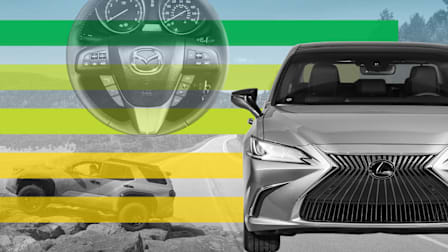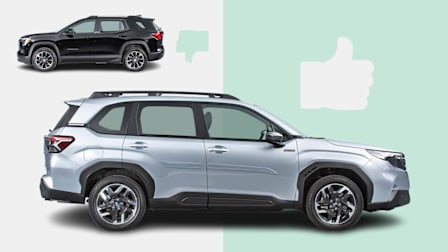How to Get a Great Deal on Your Next New Car
Our expert advice will help you find the right choice for you at the best possible price

With the average sale price of a new car close to $50,000, according to Kelley Blue Book, finding a vehicle you’ll love without paying too much for it may seem pretty difficult.
But thanks to websites that let buyers compare prices online, dealerships have an incentive to price cars competitively. Instead of haggling with a salesperson at a dealership, you can negotiate by phone and email, or use services like CR’s Build & Buy to get reasonable quotes.
Step 1: Finding the Right Car
Chances are you’ve seen ads that promise thousands of dollars off the price of a particular new car. But before you get excited about the savings, remember that unreliable or poor-performing vehicles often get the biggest price cuts at dealerships because they aren’t selling quickly. "There’s no such thing as a good deal on a bad car," says Jake Fisher, senior director of CR’s Auto Test Center. "No amount of savings will make up for high repair costs, frequent trips to the dealership, and low resale value."
Step 2: Researching Prices
You may already be aware that the price on a vehicle’s window sticker (or the one in a car ad) isn’t necessarily the final price you’ll pay, says Gabe Shenhar, associate director at Consumer Reports Auto Test Center, who has purchased hundreds of the cars CR has tested (all of them anonymously so that dealerships don’t know it’s CR doing the buying).
"Dealers are independent of the brand they’re selling, and so they can charge more (or less) than what the manufacturer suggests," he says, explaining that automakers often give dealerships bonuses if they sell lots of cars or sell specific models. "That allows the dealer to pass on the discount to the consumer if the consumer negotiates well," Shenhar says.
When negotiating, there’s more than one price you have to pay attention to:
MSRP
The manufacturer’s suggested retail price is the amount a car manufacturer determines a vehicle should sell for, and it’s often used in advertisements and displayed on a vehicle’s window sticker. You can use this price to determine whether a car will fit your budget.
Transaction Price
Including incentives and haggling, this is the amount a dealership actually charges you for a vehicle before taxes and fees. This amount could be more or less than the MSRP, depending on how much demand there is for a vehicle.
Out-the-Door Price
This is the amount you would write a check for, or the total amount your bank would finance, including taxes, fees, and extras.
The fees shown in the out-the-door price may include:
Destination fee: This is a non-negotiable charge for transporting the vehicle from the factory to the dealership.
Documentation fee: Sometimes called a conveyance fee, this is the fee a dealership charges to cover the cost of processing documents related to a vehicle sale. Some states cap the amount that dealers can charge. We’ve seen fees as low as $70 in California and as high as $900 in Florida. Many dealerships will not negotiate a documentation fee, but Shenhar says you can always ask the salesperson to reduce the price of the car itself accordingly, because salespeople have more flexibility there. The best way to avoid paying more than someone else is to research prices by using services such as CR’s Build & Buy program. It is powered by data from TrueCar, a CR partner, which tracks real transaction prices from over 12,000 dealerships across the country. Build & Buy will tell you what other buyers in your area have paid for similar vehicles, and what prices are considered a good or bad deal. It will also connect you with dealerships to get up-front price offers. (Edmunds offers a similar service, and CarGurus analyzes the prices of used cars.)
"Only by knowing the typical transaction price can you know if you are getting a good deal and how aggressively to negotiate for a discount," says Todd Young, senior data analytics specialist at CR.
For example, if you’re shopping for a 2025 Ford Explorer in Kansas City, Mo., you might think you got a good deal if you paid $42,270, which is less than the car’s $43,380 MSRP. But according to CR’s Build & Buy service, you actually got a bad deal, because some local buyers negotiated the price down to $40,465.
Once you have Build & Buy’s pricing data, email or call a dealership and ask for its best price on the car you want. If the price is too high, start negotiating for the lower price you know other buyers have already gotten on the same vehicle. Alternatively, Build & Buy will put local dealerships in touch with you to offer prices for the vehicle you want.
We recommend creating a separate, free email account for this purpose—based on our experience, you’ll get a lot of emails from dealerships that want your business.
It’s important to have realistic expectations. CR’s analysis of TrueCar data shows that, for vehicles that sell below MSRP, discounts usually range from a few hundred dollars to a couple of thousands less than MSRP—so don’t expect to talk a dealer into $3,000 off a popular new model. Instead, look for vehicles that are already priced close to what Build & Buy says is a good deal.
Our analysis of pricing data uncovered a few more tips to keep in mind:
- The less expensive a car is, the less you should expect to save off MSRP. Profit margins are too small for dealers to discount much on cars priced around $25,000 or below.
- Big savings are often available on luxury vehicles—including cars, trucks, and SUVs—which have wider profit margins than less-expensive cars. A few may sell for more than $5,000 below MSRP.
- We saw huge discounts—between $5,000 and $10,000—on luxury electric vehicles from European automakers. Be aware that EVs tend to have higher depreciation than gas or hybrid cars, so those up-front savings might cost you more in the long run when it’s time to sell or trade in the vehicle. You won’t be able to negotiate discounts on vehicles from EV brands such as Tesla, Lucid, and Rivian, which are sold directly to consumers, but they do occasionally drop (and raise) prices.
- Popular models with a lot of hype surrounding them rarely sell at a discount. For example, our pricing data shows that the Toyota Highlander Hybrid—a top-rated, fuel-saving, three-row SUV—can sell for about $2,000 above MSRP, depending on trim level. "For some cars, paying $1,000 over sticker price is actually a great deal because it can be a lot less than most other customers have paid for that car," Young says.
Step 3: Negotiating With the Dealership
Every car transaction includes some legitimate charges beyond the MSRP, such as destination, registration, and title fees, as well as taxes. But some dealers will advertise an artificially low price to get shoppers in the door, only to add a "dealer markup" fee or add on costly extras with artificially inflated prices. These are merely ways for dealers to increase their profit margins, so feel free to push back when negotiating, says Shenhar.
In 2022, the Federal Trade Commission proposed new regulations that prevent dealerships from using these kinds of sales tactics. Known as the Combatting Auto Retail Scams (CARS) Rule, it was struck down by an appeals court in 2025 after challenges from dealership trade groups.
Absent regulation, the best way to protect yourself from an expensive surprise is to ask the salesperson for an itemized out-the-door price in writing as soon as you agree on a transaction price. It should show every tax, fee, and extra charge in writing, including every discount you qualify for. If an out-the-door price adds up to a bad deal, walk away and go to a dealer that doesn’t engage in these tactics.
Why Last Year's Car Could Save You Money
Buying a "leftover" model could cut your costs—and sometimes get you a better car, too.
You might have heard a dealership advertise discounts on leftovers in order to make room for newer models. Buying last year’s model can be a way to pay less for what is essentially the same car as this year’s version.
Our analysis of TrueCar price data showed that discounts were rare on 2025 model year vehicles when they first started appearing at dealerships in the summer of 2024. At the same time, discounts on some 2024 models were over $2,000. Despite those savings, there are some pitfalls to watch out for when choosing between a new model and a leftover car.
First, cross-check which features are on the new model and on the leftover you plan to buy, because availability changes from year to year. For example, the 2024 Hyundai Palisade SEL AWD had standard auto-dimming side mirrors across all trims, but they were dropped from the SEL trim for 2025. That makes this leftover model better-equipped than a new one, but that is a rare occurrence.

Photo: Hyundai Photo: Hyundai
If you’re financing a car, automakers may offer different promotional interest rates depending on model year. The savings could add up to thousands of dollars over the life of a loan, so be sure to factor them into your decision.
It might be smart to buy last year’s model if the newer one got a major update. "Years of assessing reliability has shown us that the first years of a new model usually have the most problems, and those issues tend to get sorted out in subsequent years," says CR’s Fisher.
Finally, remember that buying a leftover model means you’re already a year behind on depreciation when it comes time to sell or trade in the vehicle.
Secrets to Big Car Savings
Determine a Reasonable Interest Rate
Check the automaker’s website for promotional interest rates. Sites like Bankrate, LendingTree, and NerdWallet will tell you what rates banks and credit unions are offering.
Know What Your Trade-In Is Worth
Get an offer from CR’s Build & Buy, CarMax, Carvana, or a local dealer. Trade in your car only if the dealer will offer more. (Use CR’s Trade-In Estimator.)
Target Your Transaction Price
Using CR’s Build & Buy service, find out what others in your area are paying for the same vehicle and use that information to negotiate a good price.
Get an Out-the-Door Price in Writing
Either over email or in person, make sure the dealer shows you an itemized out-the-door price so you’re not surprised by hidden fees.
Decline Add-Ons or Ask for Discounts
Be prepared to get the hard sell when you go to the finance office. Be ready to say "no" to the extras you don’t want.
Which Car Should You Buy?
A great deal isn’t just about the up-front price. You also need to consider how much a car costs to own and how much you’ll get when it’s time to trade it in or sell it. Compare the average transaction prices, predicted reliability ratings, and projected resale value over four years. Getting a discount on an unreliable car or a vehicle with poor resale value isn’t going to save you money in the long run.
For example, even though the 2025 Volvo XC40 is heavily discounted, the larger and pricier Lexus NX will cost you less to own in the long run. The XC40’s discount can’t make up for its lower predicted resale value or potential reliability issues.
Editor’s Note: This article also appeared in the November/December 2024 issue of Consumer Reports magazine.




















